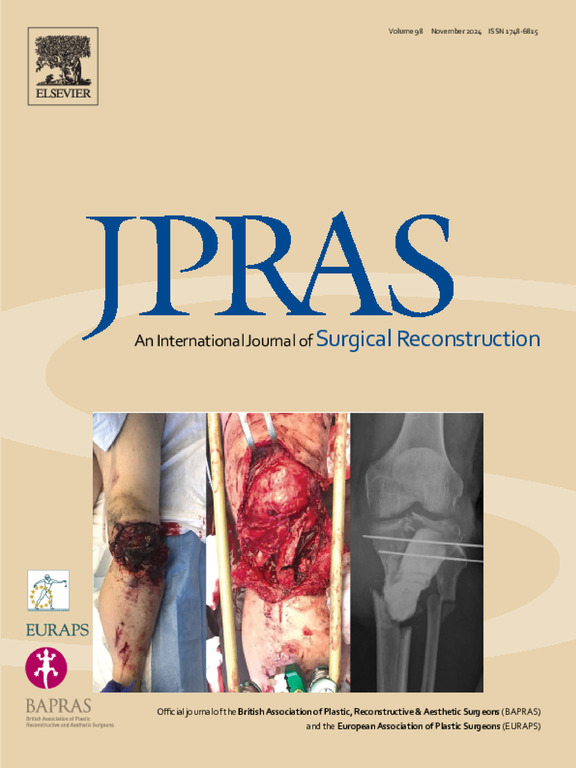头颈部粘膜游离皮瓣重建后口腔喂养的时机-系统回顾和荟萃分析
IF 2
3区 医学
Q2 SURGERY
Journal of Plastic Reconstructive and Aesthetic Surgery
Pub Date : 2025-06-11
DOI:10.1016/j.bjps.2025.06.004
引用次数: 0
摘要
背景头颈部粘膜自由皮瓣重建术后的口服喂养时机是一个非常有争议的问题。典型的6-12天“口无痰”主要是为了担心术后并发症。相反,早期喂养已被证明可以减少患者的应激反应,优化生理功能,促进恢复和愈合。然而,口服喂养的最佳时间尚不清楚,早期喂养对术后并发症和住院时间(LOS)的影响仍存在争议。方法对数据库进行系统评价;Medline (Pubmed)、EMBASE、Cochrane Central和Scopus对涉及粘膜自由瓣的头颈部重建手术后早期(≤5天)和/或晚期(≤5天)口服喂养的结果进行比较的研究。采用固定效应和随机效应荟萃分析。结果共检索到1283篇文献,其中13篇符合纳入标准,共纳入患者1657例。早期喂养与瘘管风险降低显著相关(3.66% vs 11.35%) (RR 0.37, 95%CI 0.22 ~ 0.64;P = 0.0004)和较低的肺炎风险(6.31% vs 12.38%) (RR = 0.53, 95%CI 0.33 ~ 0.87;P = 0.011)。与后期喂养相比,早期喂养显著降低了LOS (x′=9.85 vs 13.11天)(MD = 4.10, 95%CI为- 7.07至- 1.14;P = 0.0067)。两组间皮瓣衰竭、血肿和裂开的发生率相似。结论早期开始口服喂养似乎是安全的,并且与改善或相似的患者预后和降低LOS相关。外科医生应考虑对精心挑选的人群进行早期口服喂养。本文章由计算机程序翻译,如有差异,请以英文原文为准。
Timing of oral feeding following head and neck mucosal free flap reconstruction – A systematic review and meta-analysis
Background
Timing of oral feeding following head and neck mucosal free-flap reconstruction is a highly contentious issue. The typical 6–12 days “nil-by-mouth’ primarily revolves around the concern for post-operative complications. Conversely, early feeding has been shown to reduce the patient’s stress response, optimise physiological function, and facilitate recovery and healing. Nevertheless, the optimum time of oral feeding is unknown, and the impact of early feeding on post-operative complications and length of hospital stay (LOS) remains controversial.
Methods
A systematic review was conducted across the databases; Medline (Pubmed), EMBASE, Cochrane Central, and Scopus for studies comparing the outcomes of early (≤5 days) and/or late (>5 days) oral feeding following reconstructive head and neck surgery involving mucosal free-flaps. Fixed and random-effects meta-analyses were utilised.
Results
The search yielded 1283 articles, of which thirteen met the inclusion criteria, encompassing a total of 1657 patients. Early feeding was significantly associated with lower risk of fistulas (3.66% vs 11.35%) (RR 0.37, 95%CI 0.22 to 0.64; P = 0.0004) and lower risk of pneumonia (6.31% vs 12.38%) (RR = 0.53, 95%CI 0.33 to 0.87; P = 0.011) compared to late feeding. Early feeding significantly reduced LOS compared to late feeding (x̄=9.85 vs 13.11 days) (MD −4.10, 95%CI −7.07 to −1.14; P=0.0067). The incidence of flap-failure, haematoma and dehiscence was similar between the two groups.
Conclusions
Early oral feeding initiation appears to be safe and associated with improved or similar patient outcomes and reduced LOS. Surgeons should consider early oral feeding in a carefully selected population.
求助全文
通过发布文献求助,成功后即可免费获取论文全文。
去求助
来源期刊
CiteScore
3.10
自引率
11.10%
发文量
578
审稿时长
3.5 months
期刊介绍:
JPRAS An International Journal of Surgical Reconstruction is one of the world''s leading international journals, covering all the reconstructive and aesthetic aspects of plastic surgery.
The journal presents the latest surgical procedures with audit and outcome studies of new and established techniques in plastic surgery including: cleft lip and palate and other heads and neck surgery, hand surgery, lower limb trauma, burns, skin cancer, breast surgery and aesthetic surgery.

 求助内容:
求助内容: 应助结果提醒方式:
应助结果提醒方式:


